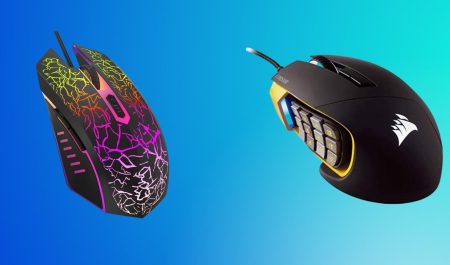Wired Or Wireless Gaming Mouse (Choice)
There are pros and cons to both wired and the best gaming Mouse. The biggest pro of a wired mouse is the fact that it’s more stable and less likely to lose connection. This is especially important for high-end gaming mice, where even the slightest hiccup can cause your cursor to jump all over the screen or worse, cause you to lose a round of multiplayer gaming.
Wireless gaming mice do have their advantages as well. For one, they’re usually much faster than their wired counterparts. That’s because there’s no need to connect them each time you want to use them; they just work thanks to the wireless signal transmitted by your computer. Wireless gaming mice can also be more versatile since you can position them anywhere on your desktop without having to worry about cable tangles.
CPI And DPI Levels (Higher is Better For Gaming)
Gaming mice have come a long way since their introduction in the late 1990s. Today’s high-end gaming mice sport a plethora of features and capabilities, including CPI (CPI stands for degrees per inch) and DPI ( DPI stands for dots per inch ). What is the difference between these two? CPI measures how quickly your cursor moves on the screen while DPI measures how many individual points are displayed on the screen at any one time.
For most users, CPI is more important than DPI. Why? Simply because higher CPI values allow your cursor to move faster over large areas of the screen, while lower DPI values allow you to see more detail at each touchpoint.
Lightweight Or Heavy Base (Lighter Or Heavier Mouse)
Gaming mouse weight is one of the most important factors when choosing a gaming mouse. Not only does it affect the comfortability of using the mouse, but also its responsiveness. If you’re looking for the best gaming mouse for your needs, you’ll want to make sure that the weight is comfortable and doesn’t affect your gameplay. In this article, we’ll discuss everything you need to know about gaming mouse weight and how it affects your gaming experience.
There are a few different factors that contribute to a gaming mouse’s weight. The main components of a gaming mouse are the sensor, receiver, and buttons. Each part can have a significant impact on weight. For example, a heavier sensor will cause more strain on your hand over time, while a lighter receiver will be more responsive. Buttons also play a role in how heavy a gaming mouse is.
Gaming Mouse Sensors (Optical Or Laser)
No matter which type of gaming mouse you use, the sensor is a key component. In this roundup, we’ll take a look at everything you need to know about gaming mouse sensors. So whether you’re looking for the best sensor for tracking movement in your game or just want to understand what makes them different, read on! Gaming mice come in all shapes and sizes, but they all have one thing in common- their sensors.
These tiny components measure how much movement the user makes and send that information to the computer as input. That’s why it’s so important that the sensor works well- if it doesn’t accurately track movement, your game will be frustratingly inaccurate too! There are three main types of gaming mouse sensors: optical, laser, and infra-red.
Additional Buttons For Macros Functions
Gaming mouse playstyle is an important aspect of gaming. It can make or break your experience and it’s crucial to choose the right mouse for you. In this article, we will explore everything you need to know about the gaming mouse playstyle and help you find the perfect one for your needs. First, let’s consider what type of gamer you are.
A few key factors to consider include your hand size, grip style, and preferred movement style. If you have small hands, a palm-grip mouse may be best for you. For gamers who prefer a claw grip, traditional mice might be more comfortable. If you’re a gamer who likes to move their hand around a lot, then a pointer or ambidextrous design might be best for you.
Gaming Mouse Vs Normal Mouse, What’s The Difference?

A gaming mouse is different from a normal mouse because it has more buttons and it is designed for gamers with high-quality optical and laser sensors. The significant difference between a gaming mouse and a regular one is having a much higher DPI, ergonomics, and the ability to save different settings for different actions with multiple buttons.
This means when you’re using a gaming mouse, the cursor on the screen will move faster when you move the mouse and you will find lots of settings surrounding to improve your gaming experience. Additionally, most gaming mouse also has a weight adjustment system so that you can make them heavier or lighter depending on your preferences.
If you want to make a decision, optical vs laser mouse, which is better? Here are facts that help:
- The best optical mouse sensor can reach a resolution of around 3,000 DPI (dot per inch) in its capacity.
- A laser mouse sensor can normally provide a resolution between 8,000 and 20,000+ DPI, and faster with tracking more dots per inch area.
- Generally, a normal office mouse comes with optical sensors with limited DPI, however, gaming mouses come with both high-end optical and laser sensors with the desired range of DPI, sensors, and features from particular brands.


